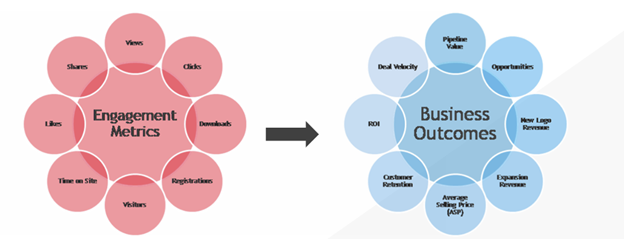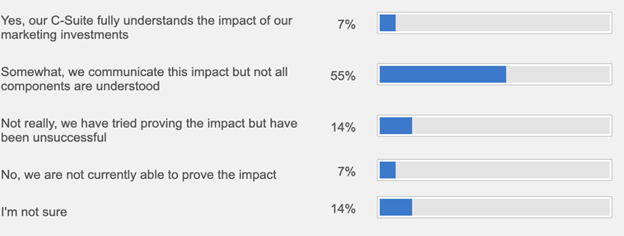
It’s a tough economy, and many businesses are pulling back on their marketing investments. Traditionally, marketing has been regarded by executive staff as more of a cost center than a revenue generator, so marketing budgets are often the first to get cut when money is tight.
To ensure their budgets stay intact, marketers face a number of significant challenges. To overcome the perception of marketing as a cost center, they must demonstrate to executive staff that revenue can be attributed to their efforts. This requires using marketing attribution to track various marketing activities and tie them to business outcomes.
In a recent webinar, Adobe’s Senior Strategic Value Advisor, Tara Spec, and BDO Digital’s Senior Advisor of Demand Generation, Will Waugh, took a deep dive into what metrics marketing teams should track, and the various attribution models available for demonstrating marketing’s impact on business outcomes. They also took a closer look at Adobe Marketo Measure, formerly Bizable, and how the tool can be used to track, attribute and report on revenue tied to marketing activities.
So Many Metrics, So Little Time
According to Tara, only 15% of marketers say their teams are effective at performance measurement. One reason for that is that there are so many metrics to track! Marketers must monitor visits, clicks, shares, time on page, downloads and more and map those activities to numerous business outcomes (see Figure 1).

Figure 1: Connecting marketing activity to business outcomes.
“There are tons of expectations, and for some of us, it’s almost impossible to tie engagement metrics to business outcomes,” she said, adding that most of us resort to using Excel spreadsheets and other manual processes. These methods are inadequate when it comes to complex reporting requirements.
Let’s say you’re running an online event. The Digital team is tracking traffic, cost per click and impressions. The Events team is interested in registration, attendance rates and follow up metrics. Demand Generation wants to know about qualified leads, cost per lead and time for conversion. But what about the Finance team? Finance isn’t as interested in engagement – they want to see ROI, profit & loss calculations and budget adherence. “The challenge is to stitch these all together and present a meaningful story to all stakeholders,” Tara said.
Webinar attendees agreed – only 7% say they’re able to fully communicate the impact of marketing investments on revenue (see Figure 2).

strong>Figure 2: A webinar poll revealed the majority of marketers have trouble tying marketing’s impact to revenue.
Using Marketing Attribution to Prove Marketing’s Impact
In recent years, Marketing teams have adopted marketing attribution models to help make sense of all the various metrics they must track and tie them to business outcomes.
“Marketing attribution is an analytical approach to determining which marketing channels and touchpoints that a customer encounters on their path to purchase contribute to pipeline creation and revenue,” Tara said. “It helps you get to a place of being able to account for every dollar of marketing spend and understand what’s effective, so you can spend more on what’s working and less on what’s not.”
Effective marketing attribution can help you answer some complex questions, including:
- What was the overall contribution by Marketing to pipeline and revenue?
- What was the ROI of marketing spend by campaign, channel and asset?
- Which campaigns drove the most pipeline opportunities?
- Which channels were most effective at driving revenue?
- Which offer types were most effective at filling the funnel?
- Where should I allocate my marketing budget to drive the best results?
“Being able to answer these questions, get you in a better position to get your budget approved for the following year,” said Tara.
Having these types of insights into the impact of marketing activities is particularly important in B2B organizations, where there are multiple people on the buying committee, all using different channels to find information about products and services.
“For a single buy, sometimes you’re selling to six or 10 different people on multiple channels for a single purchase,” Tara said. “Those channels are often totally siloed, so being able to see metrics for all of those different marketing channels and weave them into a cohesive ROI story can be almost impossible, without an effective attribution model.” Among the webinar attendees, 33% reported that siloed data across channels and tools was the biggest challenge related to proving marketing’s impact.

Figure 3: The B2B Buyers’ Journey is Expanding.
Full-Touch Marketing Attribution Provides a Complete Picture
To demonstrate Marketing’s contribution to closed won deals, implementing a marketing attribution model is essential. There are several different attribution models (you can learn about them in this blog post):
- Single-touch models are simple and straightforward, but only tell part of the story, giving credit only to either the first or last touchpoint a customer engages with on their path to purchase.
- Conventional multi-touch attribution models that divide credit among all marketing activities along the buyer’s path to purchase provide a little more information, but still don’t paint a complete picture.
Instead, Tara recommends a full-funnel custom attribution model, made possible by advanced technology like Marketo Measure. Full funnel attribution enables you to get granular data about which marketing touchpoints influenced a sale throughout the buying journey (see Figure 4).

Figure 4: Custom full-funnel attribution model.
According to Tara, the type of attribution model used depends on an organization’s attribution maturity model. Full-funnel attribution is used by those further along on the maturity scale, enabling teams to:
- Run custom models to estimate attribution across all channels
- Accurately attribute marketing’s value despite complex sales cycles
- Track the value of sophisticated multi channel marketing programs
- Partner with sales on pipeline acceleration strategies
Companies who implement full-funnel attribution with Marketo Measure can increase MQL volume by 15% and grow closed won deals by 25%. Importantly, the information generated by the model can be used to quickly and effectively demonstrate Marketing’s contributions to the pipeline – and the bottom line.
BDO Digital – Your Partner for Marketing Attribution Success
Now is the time to revisit your attribution strategy. BDO Digital partners with Adobe and BDO Digital and offers two implementation packages to meet the needs of companies at various stages of their attribution journey.
To learn more about how we can help you uplevel marketing attribution in your organization, contact us today for a consultation.
The post Marketing In A Tough Economy: How to Make Every Dollar Count appeared first on DemandGen.










![Salesforce Campaigns: Why You Should Customize Campaign Objects [Part 2]](https://content.cdntwrk.com/mediaproxy?url=https%3A%2F%2Fi.ytimg.com%2Fvi%2FYswfbjbWZ5Q%2Fhqdefault.jpg&size=1&version=1665679078&sig=6e89f8b8c597af172aa23be99085be2d&default=hubs%2Ftilebg-videos.jpg)


